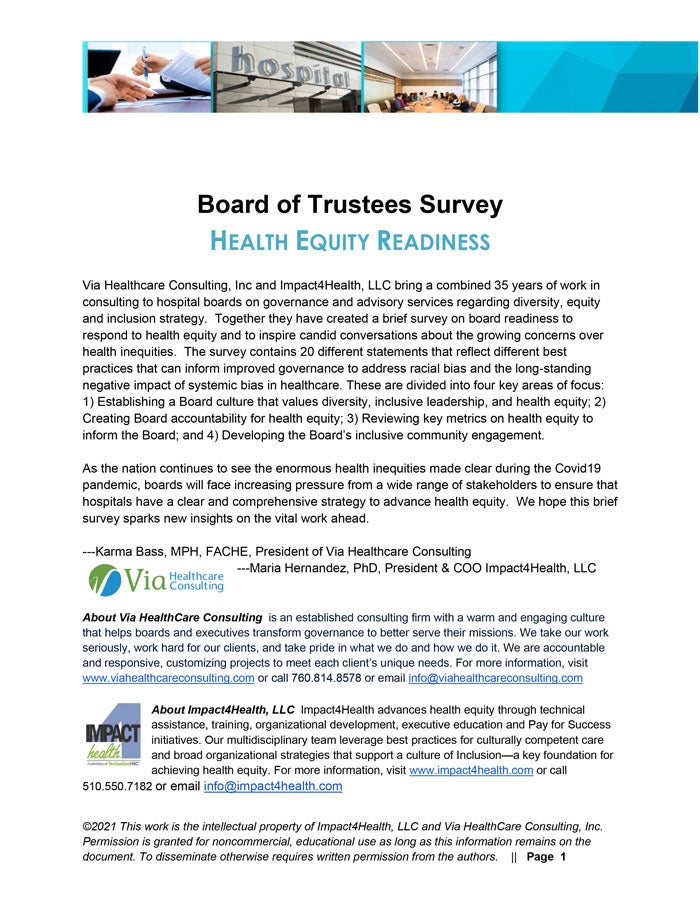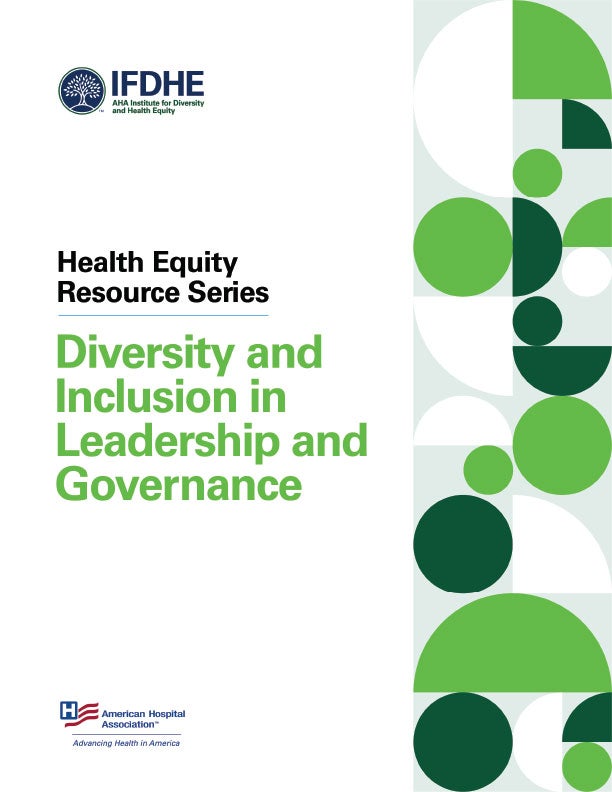
Health Equity
Board Diversity Survey to Advance Health Equity
New survey tool helps evaluate a board’s potential
By Maria Hernandez and Karma H. Bass
Health equity is not a new issue; but those who witnessed or experienced the inequitable outcomes of the pandemic are raising their voices louder, demanding action by health care leaders to root out causes and bring systemic change.
As overseers of anchor organizations in communities, health care trustees recognize that it is their duty to respond to these demands. Boards are having important discussions about racism, systemic bias and a history of medicine and health care marked by racial injustice and discrimination. For some boards that are more accustomed to conversations about financials, balance sheets and community good, these discussions may be uncomfortable. To support their forays into these challenging topics, many boards may need additional guidance and new tools.
For some boards, this area of discussion and work represents a huge change — in policies, approaches and, perhaps greatest of all, mindset. Advancing health equity requires a comprehensive, coordinated approach across the hospital or health system, with clear accountability by every hospital leader and board member.
Before trustees can embark on this work, they should take stock of where they are — as a group — in being ready for these conversations. Not all boards come to these discussions from the same level of knowledge or awareness. Boards will have some individuals who have not had as much experience, education or training on topics related to health equity as others.
For this reason, we developed a survey tool that all boards can use to identify their strengths and weaknesses as they prepare for advancing health equity within their communities. We recommend all individual board members complete this survey, and then the full board reviews a summary that includes frequency of responses (as well as averages). Boards need to understand which areas individual board members hold widely differing views so that room can be devoted to discussing them. A divided board will not be effective leading the organization through change.
Here we highlight the survey’s four sections, which can support important, candid conversations among hospital trustees.
Key Areas of Focus
We have found that self-assessment of board readiness to advance health equity encompasses four key areas: board culture, board accountability, metrics on inclusion and health equity, and inclusive community engagement.
Board Culture
As legendary management consultant Peter Drucker said, “Culture eats strategy for breakfast.” Nowhere is this truer than in the leadership suites and boardrooms of U.S. hospitals and health systems. While board culture may be a mutable, hard-to-measure characteristic, there are a few questions, if asked, that can provide insight into it.
For instance, do board meetings consist primarily of presentations, or is there interactive dialogue on substantive issues? Are collegial, respectful tones used in conversation? And tellingly, do all board members participate evenly, or are a few board members dominating the discussion? In addition, are all board members encouraged to ask probing questions and offer their individual insights, or is the floor reserved for those considered to be “experts” or most senior members?
While these questions may seem unrelated to health equity, the answers illuminate whether the board culture is inclusive and supportive of diversity. Diversity in the boardroom increases an organization’s effectiveness because it helps prevent groupthink and fosters consideration of a broad range of options. Health care is characterized as an insular field at times, but greater diversity of thought and perspectives can help overcome that tendency.
Attaining an inclusive and diverse board culture requires board members who are willing to engage in difficult conversations and, at times, be personally uncomfortable. Boards should be talking about racism and the long-standing, negative impact of systemic bias in health care. To effect real change, this work will need to be intentional and come from a place of cultural humility.
Hospital and health system boards have taken on a sacrosanct responsibility to ensure their organizations serve all the members of their community. This means that the board itself must represent the diverse communities it serves. If the board does not currently reflect the racial, ethnic or cultural diversity of its patient populations, then all recruitment efforts must include this as a focus area. Resources are available to support boards in becoming more diverse; passive acceptance of the status quo will no longer be acceptable.
Board Accountability
Board accountability includes how the board holds itself and its executive and clinical leaders accountable to goals — especially important for the challenging work of changing inequitable health outcomes that are driven by deeply entrenched practices.
As the ultimate authority over everything that happens in the organization, the board has power that often goes untapped. Too often, boards approve plans and goals but never hear about them again. In its checks-and-balances role, the board should hold leadership accountable to the organization’s highest-level, agreed-upon goals around health equity. These goals are imperative to true improvement and should have regular measurement, reporting and accountability for achieving them.
To ensure buy-in, understanding and accountability to these health equity goals, the board should frequently discuss the link between quality of care and the organization’s existing health equity initiatives, community health programs, and policies. The board must then link its work around care access and quality to the organization’s findings on outcomes and patient experience, stratified by demographic group.
The board (or a committee) also should regularly receive updates on organizational programs focused on health equity as well as updates on health inequity indicators that have been tailored to the organization. When there are gaps between health equity targets and actual performance, boards should ask questions to ensure that plans are in place to address these gaps.
Each board member also should understand that, just as with their oversight of quality, health equity is every trustee’s responsibility. The board should not rely on one member or only those from underrepresented groups to advance this cause. While champions are critical to this work, all board members must be engaged in and understand their individual responsibility to support health equity work.
Finally, boards must be sure to use care in exercising their authority to hold leaders accountable, so the effort doesn’t backfire and result in demoralized staff and unnecessary turnover at the top. For this reason, the board also needs to hold itself accountable to fair, measured and gracious behavior in its interactions. These are difficult conversations, but visionary leaders make room for struggle and imperfect execution while being steadfastly focused on the ultimate goal of equitable treatment and optimal outcomes for all patients and communities.
When done well and in partnership with leadership, this work can spur the organization to change. Chief executives and medical staff leaders can tell their teams and colleagues, “The board insists that we get this work done.”
Metrics on Inclusion and Health Equity
Understanding what it takes to achieve health equity requires boards to be informed about the types of data required to assess their organization’s strategy and performance. Most boards review a quality metrics dashboard that includes quarterly summaries on a number of factors. Three common metrics include satisfaction ratings from patients about their hospital experience — for example, Hospital Consumer Assessment of Healthcare Providers and Systems (HCAHPS) scores — and 30-day rehospitalization rates.
To champion health equity, data should be stratified by demographic groups. The most common groupings used in health care are race, ethnicity and language preference (REaL data) and sexual orientation and gender identity. Only when data is reviewed with this level of detail can a board truly assess whether culturally competent care is being provided to meet the unique needs of each patient.
Boards also must dig in and do their homework to understand the meaning of health inequities and disparities and gauge the prevalence of specific diseases in their communities and the accessibility of their hospital’s services. For example, if a health care organization serves a community that is comprised of 25% Latino residents, and the hospital’s patient population is only 10% Latino, it’s important to ask how welcoming and accessible the hospital is to this segment of the population. Where does the rest of the Latino community go for health care? Further, if a hospital’s patient population is 10% Latino, but Latinos account for 30% of all rehospitalization rates, what is happening that puts Latino patients at risk for less-than-ideal health outcomes?
In the U.S. today, cancer, heart disease, diabetes and behavioral health are conditions with the biggest gaps in health equities. Start by asking: What do we know about these conditions in our community and at our hospital? Not all health systems have the ability to supply this kind of demographic data; but boards must ask how to build capacity to support this level of analysis and request that their organizations begin collecting such data.
Health care has become more complex, and it takes a broader and more in-depth understanding of the issues and terms to oversee high-quality, equitable care. Board members should become conversant in the language of epidemiology, public health, population health, and statistics. It is essential to hold special educational sessions on single topics regarding health equity with subject matter experts from local universities, public health departments and internal hospital departments to better understand the data available. As we often tell our clients’ boards, “board service may be a volunteer activity, but board members should not be amateurs when it comes to understanding the issues.”
Complete reliance on the expertise of board members who are physicians, public health experts or accountants is not good governance. Every hospital or health system board benefits from each member being full engaged.
Inclusive Community Engagement
As more evidence emerges about the impact of social determinants of health — factors linked to communities and neighborhoods where people live and work, access to healthy food and quality housing — hospitals are looking to engage community partners. The board’s role in community engagement reflects health care’s shift to investing in housing, food pantries or community gardens, free transportation, or in-home interventions to coordinate and deliver culturally competent care where patients live.
One approach to better understanding their communities is for boards to “meet on a bus.” Board members hold a meeting while visiting different community centers or faith-based groups so that members can observe and learn about their community firsthand. By holding “town halls” in these venues, boards can invite residents to speak about their hospital experience and the health needs they see in their community.
A key tool for boards is the community health needs assessment, which all nonprofit hospitals are required to conduct every three years. The CHNA should report health needs in the communities and how resources are being used to respond to the identified community need. The board can then ask for clear accountability on addressing those needs and how the organization frames its community health investment to advance health equity.
The board should encourage strategic community partnerships and ensure that the hospital or health system’s management team is willing to work and collaborate according to existing frameworks within the community, rather than imposing its own. This is where inclusive leadership, cultural humility and empathy become key leadership skills that can define the success of a board and the CEO.
Follow-up and Follow-through
Once a board has completed the health equity readiness board assessment, the real work begins. If efforts stop after completing the assessment, the board likely will not be successful in ensuring equitable care. Follow-through is essential, and boards should consider the self-assessment as a starting point for the conversation.
Follow-up steps include:
- Collect survey responses from all board members and have the results collated to show averages as well as frequency of responses.
- Hold a special session to discuss the results of the health equity readiness board self-assessment.
- Prioritize and focus on two to three areas.
- Develop an action plan to address the focus areas.
- Include a review of progress on the action plan as a regular agenda item at board meetings.
Even a board that scores well on the assessment should still do this follow-up work. Based on our experience with hospital and health system performance with health equity, most organizations have a long road ahead on the journey to improvement. We would expect that most boards will not score very high on the assessment. A low score might reflect a board that has been truly forthright in its self-assessment and recognizes the hard work to be done. In fact, boards should celebrate its members’ honest answers, even if the score is lower, as a sign that the board is ready to undertake this work seriously.
We believe that the scores themselves are less important than the thought-provoking and educational process the self-assessment is designed to generate. A low score should serve as a wake-up call on areas that a board should focus on and the strategic initiatives that should be in place. The self-assessment represents an opportunity to uncover issues that have been hidden for far too long. It is time these issues are brought to light and addressed. For many trustees, a good place to develop a foundational understanding of these issues is with the AHA’s Institute for Diversity and Health Equity’s toolkit.
An Ongoing Journey
Achieving equitable care also is a continuing learning process. Boards should not mistake a few achievements for the end of their work. It is an ongoing journey. Trustees must continuously assess their board’s readiness and their organization’s performance on health equity and seek learning opportunities for improvement. New research and approaches to address health equity are ongoing, and boards should be familiar with this work.
If done well, this work will result in change from the inside out and the top down. Your board, your organization and health outcomes should transform as the journey progresses.
Once health equity becomes embedded within an organization’s mindset, all decision-making, policies and initiatives will be imbued with the fundamental question: How does this work affect this group of people?
The work will not be easy. Virtuous work is hard work. A long hard look within is unavoidable because so many lives are at stake. It must be done.
Maria Hernandez, Ph.D., (maria@impact4health.com) s president and COO of Impact4Health and based in Oakland, California. Karma H. Bass, M.P.H., (kbass@viahcc.com) is senior principal with Via Healthcare Consulting and based in Carlsbad, California.
Please note that the views of authors do not always reflect the views of the AHA.


